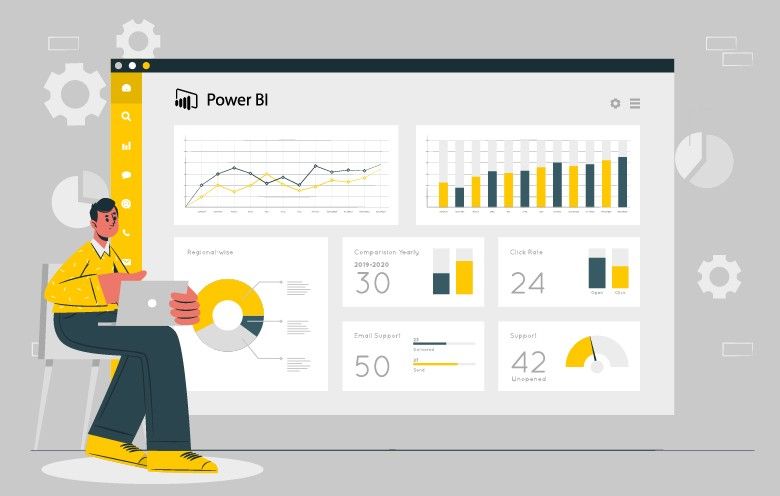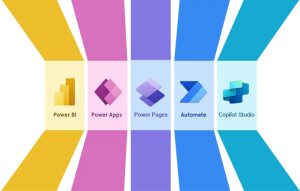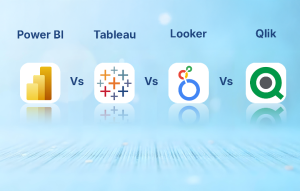Power BI is one of the leading tools that merges data preparation, data discovery, interactive dashboards and rich visualizations into a single solution. Its capabilities make it an intuitive tool for handling data and getting insights out of it. This blog post aims to highlight the top six reasons why you should choose to utilize business intelligence with Power BI for business analytics and data analytics.
1. Connect your data sources quickly
Power BI not only makes it simple to bring all of your data into one place for easier access but also delivers increased visibility in your reporting efforts. It supports up to 70 connectors, enabling businesses to load data from a variety of popular cloud-based sources, including Azure Data Warehouse, DropBox, Google Analytics, OneDrive, Salesforce CRM as well as Excel spreadsheets, CSV files and data stored on-premises, such as SQL Database.
Additionally, you can leverage pre-built Power BI dashboards in seconds and perform powerful data analysis in minutes using connectors. Moreover, you can easily customize elements further to your liking, or have your data experts import your datasets and develop your dashboards and reports.
Data360 Program = Customized Consulting + Services
2. Become powerful and efficient
Power BI delivers real-time access to critical data via interactive, immersive Power BI dashboards. Hence, users can quickly solve issues and identify opportunities. Various researches have stated that the average weekly savings are 1.25 hours, with total organizational efficiencies exceeding $3.6 million.
The data modeling engine of Power BI is a highly performant database that ensures data is fully loaded into the memory for greatest possible performance. Another interesting fact is that Power BI uses automated data schedules to ensure that data is always up to date, which is a crucial feature that helps end-users with visual reporting. In brief, Power BI provides end-users with a faster and more responsive data analysis experience.
3. Put data governance and security together
Power BI allows you to manage security, user access and security from a single interface, eliminating the need for additional solutions to ensure strict compliance and regulatory standards are met. The service also includes Azure Active Directory (AAD) for user authentication, allowing you to access your data using Single Sign-On (SSO) and your standard Power BI login credentials.
Power BI supports data democratization, which means that the solution gives several users instant access to visual data sources, allowing for customization, analysis and visualization. Technically it’s good to say that Power BI expands the quantity of data that consumers may use without increasing the size of the core IT and analytics team.
4. Deliver real-time data insights
Power BI gives businesses a single platform to suit their self-service and enterprise data analytics requirements. Users may access robust semantic models, an application lifecycle management (ALM) toolset, an open connection architecture, and fixed-layout, pixel-perfect rendered Power BI reports with combined analytics using Power BI. This allows users to receive weekly and monthly updates that improve Power BI features and capabilities, based on thousands of ideas contributed annually from a community of more than half a million members across the world.
5. Explore data in more depth
Since Power BI encourages data democratization, it aids in the development of a data-centric culture within businesses. You can empower your employees to be more data-aware and data-driven. As a result, it also improves employee retention.
Advanced Excel users who are familiar with the Data Analysis Expressions (DAX) formula language can leverage Power BI’s familiar Power Pivot tools like clustering, forecasting, grouping and quick measures to dig deeper into their data and uncover patterns more quickly. Furthermore, several users, including MS Excel users will find Power BI’s powerful toolset easy to onboard, allowing you to use existing organizational expertise and ease into Power BI faster.
6. Find answers to your data questions
Power BI users can generate visualizations and discover insights using natural language search interfaces, without the need for coding. Simply by utilizing the ‘Ask a question’ box that addresses data-specific queries such as ‘what are the recent sales figures for particular region?’ Users then may go deeper into specific insights. Interestingly, Power BI suggests meaningful questions as you write, as well as a preview of a chart or table visualization that best portrays the data you’re looking for. This may appear as a gimmick at first, but with Power BI’s natural language query engine is highly intuitive and effective with Microsoft’s continual improvements.
The potential of Power BI with Dynamics 365 CRM
While we’ve covered Power BI extensively in this blog, Dynamics 365 CRM is another business product that customers all over the world rely on. When the features of Power BI and Microsoft Dynamics 365 are integrated, it produces an unstoppable BI solution. Although many users are satisfied with Dynamics 365 CRM’s reporting capabilities, combining it with Power BI can elevate business intelligence to new heights.
Power BI provides great potential for businesses that don’t need an enterprise-level BI solution. It’s also a good fit for businesses that don’t want to spend a lot of money on high-end equipment. Overall, Power BI provides all of the essential functions that a business intelligence program should have.
Take away
It’s easy to see why businesses are turning to Power BI for improved insights, dynamic dashboards and comprehensive reporting. What is stopping you? Now is the time to leverage Power BI capabilities and accelerate towards business intelligence, improving and delivering data insights across your organization. Check out our Power BI consulting services and reach out to our Power BI consultants to discuss your requirements.









